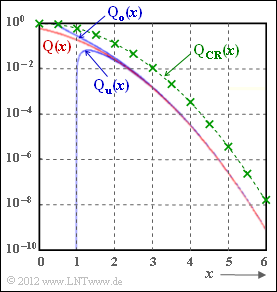Exercise 1.16Z: Bounds for the Gaussian Error Function
The probability that a zero mean Gaussian random variable $n$ with standard deviation $\sigma$ ⇒ variance $\sigma^2$ is greater in amount than a given value $A$ is equal to
- $${\rm Pr}(n > A) = {\rm Pr}(n < -A) ={\rm Q}(A/\sigma) \hspace{0.05cm}.$$
Here is used one of the most important functions for communications engineering (drawn in red in the diagram):
the "complementary Gaussian error function"
- $${\rm Q} (x) = \frac{\rm 1}{\sqrt{\rm 2\pi}}\int_{\it x}^{+\infty}\rm e^{\it -u^{\rm 2}/\rm 2}\,d \it u \hspace{0.05cm}.$$
${\rm Q}(x)$ is a monotonically decreasing function with ${\rm Q}(0) = 0.5$. For very large values of $x$, ${\rm Q}(x) tends \to 0$.
The integral of the ${\rm Q}$ function is not analytically solvable and is usually given in tabular form. From the literature, however, manageable approximations or bounds for positive $x$ values are known:
- the upper bound $($upper blue curve in adjacent graph, only valid for $x > 0)$:
- $$ {\rm Q_o}(x)=\frac{\rm 1}{\sqrt{\rm 2\pi}\cdot x}\cdot {\rm e}^{-x^{\rm 2}/\rm 2}\hspace{0.15cm} \ge \hspace{0.15cm} {\rm Q} (x) \hspace{0.05cm},$$
- the lower bound $($lower blue curve in the graph, only valid for $x > 1)$:
- $$ {\rm Q_u}(x)=\frac{\rm 1-{\rm 1}/{\it x^{\rm 2}}}{\sqrt{\rm 2\pi}\cdot x}\cdot \rm e^{-x^{\rm 2}/\rm 2} \hspace{0.15cm} \le \hspace{0.15cm} {\rm Q} (x) \hspace{0.05cm},$$
- the Chernoff-Rubin bound $($green curve in the graph, drawn for $K = 1)$:
- $${\rm Q_{CR}}(x)=K \cdot {\rm e}^{-x^{\rm 2}/\rm 2} \hspace{0.15cm} \ge \hspace{0.15cm} {\rm Q} (x) \hspace{0.05cm}.$$
In the exercise it is to be investigated to what extent these bounds can be used as approximations for ${\rm Q}(x)$ and what corruptions result.
Hints:
- This exercise belongs to the chapter block error probability bounds.
- Reference is also made to the chapter Gaussian distributed random variables in the book "Stochastic Signal Theory".
- The exercise also provides some important hints for solving Exercise 1.16, in which the function ${\rm Q}_{\rm CR}(x)$ is used to derive Bhattacharyya barrier is required for the AWGN channel.
- Further we refer to the interactive applet Complementary Gaussian Error Functions.
Questions
Musterlösung
- $${\rm Q_o}(x)=\frac{1}{\sqrt{\rm 2\pi}\cdot x}\cdot {\rm e}^{-x^{\rm 2}/\rm 2} \hspace{0.3cm} \Rightarrow \hspace{0.3cm} {\rm Q_o}(4 )=\frac{1}{\sqrt{\rm 2\pi}\cdot 4}\cdot {\rm e}^{-8 }\hspace{0.15cm}\underline{\approx 3.346 \cdot 10^{-5}}\hspace{0.05cm}.$$
- Die untere Schranke kann wie folgt umgewandelt werden:
- $${\rm Q_u}( x)=(1-1/x^2) \cdot {\rm Q_o}(x) \hspace{0.3cm} \Rightarrow \hspace{0.3cm} {\rm Q_u}(4 ) \hspace{0.15cm}\underline{\approx 3.137 \cdot 10^{-5}} \hspace{0.05cm}.$$
- Die relativen Abweichungen gegenüber dem „echten” Wert ${\rm Q}(4) = 3.167 · 10^{–5}$ sind $+5\%$ bzw. $–1\%$.
(2) Richtig sind die Lösungsvorschläge 1 und 2:
- Für $x = 2$ wird der tatsächliche Funktionswert ${\rm Q}(x) = 2.275 · 10^{–2}$ begrenzt durch ${\rm Q_{o}}(x) = 2.7 · 10^{–2}$ bzw. ${\rm Q_u}(x) = 2.025 · 10^{–2}$.
- Die relativen Abweichungen betragen demzufolge $18.7\%$ bzw. $–11\%.$
- Die letzte Aussage ist falsch: Erst für $x < 0.37$ gilt ${\rm Q_o}(x) > 1.$
(3) Für den Quotienten aus ${\rm Q}_{\rm CR}(x)$ und ${\rm Q_o}(x)$ gilt nach den vorgegebenen Gleichungen:
- $$q(x) = \frac{{\rm Q_{CR}}(x)}{{\rm Q_{o}}(x)} = \frac{{\rm exp}(-x^2/2)}{{\rm exp}(-x^2/2)/({\sqrt{2\pi} \cdot x})} = {\sqrt{2\pi} \cdot x}$$
- $$\Rightarrow \hspace{0.3cm} q(x) \approx 2.5 \cdot x \hspace{0.3cm} \Rightarrow \hspace{0.3cm} q(x =2) \hspace{0.15cm}\underline{=5}\hspace{0.05cm}, \hspace{0.2cm}q(x =4)\hspace{0.15cm}\underline{=10}\hspace{0.05cm}, \hspace{0.2cm}q(x =6) \hspace{0.15cm}\underline{=15}\hspace{0.05cm}.$$
- Je größer der Abszissenwert $x$ ist, um so ungenauer wird ${\rm Q}(x)$ durch ${\rm Q}_{\rm CR}(x)$ angenähert.
- Bei Betrachtung der Grafik auf der Angabenseite hat man (hatte ich) den Eindruck, dass ${\rm Q}_{\rm CR}(x)$ sich aus ${\rm Q}(x)$ durch Verschieben nach unten bzw. Verschieben nach oben ergibt. Das ist aber nur eine optische Täuschung und entspricht nicht dem Sachverhalt.
(4) Mit $\underline{K = 0.5}$ stimmt die neue Schranke $0.5 · {\rm Q}_{\rm CR}(x)$ für $x = 0$ exakt mit ${\rm Q}(x=0) = 0.500$ überein.
- Für größere Abszissenwerte wird damit auch die Verfälschung $q \approx 1.25 · x$ nur halb so groß.
